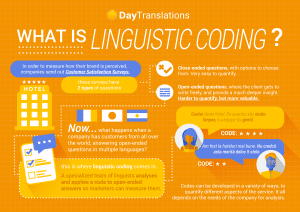What is Linguistic Coding?
One of the greatest challenges that international organizations face is keeping their processes and flow of information consistent across locales. This might require some extra effort, but it’s absolutely vital to keep our business strong and goal-focused throughout.
If we’re conducting surveys at a wide, international scale, we’ll need to rely on linguistic coding services. Linguistic coding consists of translating the answers of open-ended questions, organizing them according to certain relevant criteria, and compiling them into files that data analyzing software can work with. This process is also known as “open-end coding” or “open question coding”.
Thanks to linguistic coding, we can observe and understand the trends underlying specific linguistic nuances, and garner quantifiable, analyzable data from multilingual sources.
In this article, we’ll take a look at how linguistic coding can help businesses garner and process feedback from international customers.
How can Surveys Help my Business?
Customer-centric businesses do better than their counterparts. By proactively making our customers the core of everything we do, we’re making sure we create a product that appeals to them, does the job, and can experience relevant changes according to feedback.
Customer experience doesn’t end when the purchase is made. Keeping a base of returning customers is essential for any business. First and foremost, it provides a certain stability and predictability revenue-wise. On the other hand, it keeps your marketing investment within budget: It’s less expensive to maintain returning customers than it is to acquire new ones.
There are numberless ways to stay in touch with a satisfied customer. One of them is asking them what they think of your product. Surveys are a great tool to engage customers, and let them know they’re at the heart of our organization, and that their opinions matter. On the other hand, it can help you explain certain trends and further optimize your offer.
Integrating Salesforce customer feedback surveys into your engagement strategy can be particularly beneficial. These types of surveys are designed to seamlessly collect and analyze customer responses, which can help inform your business decisions. By using Salesforce surveys, you can gain insights directly from your customers, helping to improve the overall user experience while simultaneously optimizing your product offering.
In addition to this, for businesses looking to optimize their sales processes, exploring Salesforce sales cloud consulting can provide tailored solutions and insights to enhance efficiency and drive growth.
You can’t engage your customers if you don’t speak their language. So, if you’re operating internationally, having your post-sale surveys flawlessly translated is a given. We can’t get comparable answers if we are asking different sets of questions to different customers. But, even if everything goes well, you’ll eventually find yourself with piles of information in several different languages.
The Issue of Open-Ended Questions
Open-ended questions should be included with discretion. Through them, we offer our customers the opportunity to share their feelings in their own words, giving us an angle that, perhaps, we hadn’t thought of.
But they can lengthen the survey’s required time to completion. And a longer survey can be dense and boring for your average customer, resulting in a low response rate.
Open-ended questions are the single greatest reason why we need an experienced survey translation services provider supporting our feedback collection efforts. Through proper linguistic coding, our translation partner will be able to turn our qualitative data (our customers’ written answers) into quantitative data.
How Linguistic Coding Works
Linguistic coding begins with a precise translation of all survey answers. This is the most complicated step, since it relies on highly-experienced translators who understand the subtleties in the responses at hand.
From the translated responses, we can create a criterion to sort out our customers’ opinions. This criterion will be determined by the question they are responding to, and by what we want to know.
A simple example would be a tourist satisfaction survey at the end of a cruise. Let’s say there’s the following open-ended question: “Did you like your room?”
There might be a scale from 1 to 5, 5 being the highest mark (5 stars) and 1 being the lowest (1 star).
Let’s say the translated answer of a French customer reads: “My room was quite small, but it was nice. The room service was fantastic.”
Terms related to lukewarm discomfort, such as“quite small” would be “category 3” words, assigning the review a numeric value of 3. Meanwhile, the term “nice” would be a “category 4” word, signaling that our customer is happy — not thrilled, but happy. On the other hand, “fantastic” would be a “category 5” word, signaling that the customer is very satisfied.
So, this qualitative data can be synthesized as a 4 stars review.
Next time you read a review, consider that you can get a general sense of the customer’s opinion of the product without any connectors or nouns, just through adjectives.Through this principle, linguistic coding helps us turn qualitative data (details of the experience of an individual customer), into quantitative data that can be compiled and processed.
Linguistic coding is a partially human-powered and partially automated process. If you’re considering linguistic coding, make sure your service provider relies on highly-trained linguists and expert data scientists.













Sorry, the comment form is closed at this time.